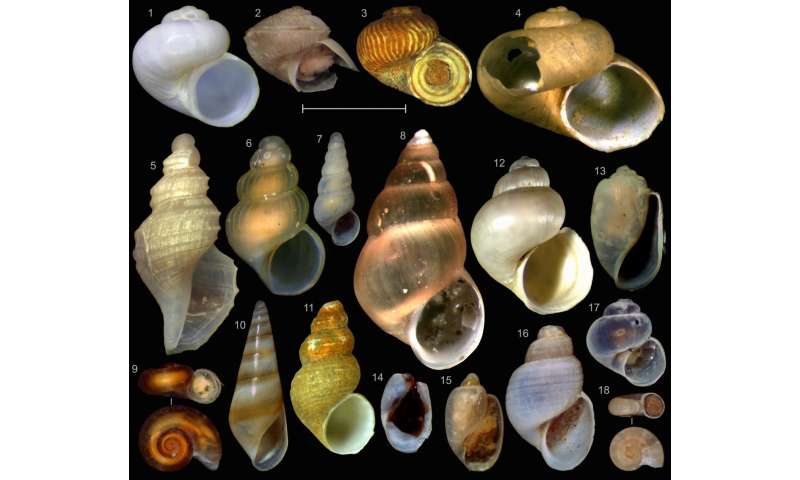
Shell-bearing microgastropods are snails whose size is less than five millimeters. They represent one of the least studied groups of metazoan living organisms in the oceans. Ivan Nekhaev is a senior research associate at the Department of Applied Ecology at St Petersburg University, and Ekaterina Krol is a doctoral student. They have summarized and analyzed the currently known information on the species composition and lifestyle of these animals in the eastern sector of the Arctic.
In total, at least 66 species of microgastropods, belonging to four subclasses, live in the region. Two of the species have already been described during recent studies by the authors of the present review. Also, descriptions of two more species are being prepared for publication. More than half of the species have had only the external appearance of the shell studied. Important details of the internal structure and sequence of genes, traditionally used in the classification of animals, remain unknown in microgastropods, as a rule.
“Starting from the 18th century, snails were classified according to their shell—each species was believed to have its own shape. Later molluscs began to be dissected and only at the current stage scientists have started studying their DNA. These studies have shown inconsistency in the classification by shell,” explained Ivan Nekhaev, the first author of the article. “Studying these animals is not easy. Imagine a two-millimeter mollusc in front of you. From it, you need to extract its reproductive system, which is already tenths of a millimeter. This is a very delicate, laborious and meticulous work.”
According to Ivan Nekhaev, the biological diversity of the Arctic has been studied extremely unevenly. There is a relatively large amount of data on large animals that are easy to see. However, there is very little information on other groups such as micromolluscs, which include shell microgastropods. Scientists need this information in order to understand: what the Arctic is like; how its fauna was formed; and how ecosystems respond to climate changes associated with human activities.
Arctic molluscs regularly become central figures in publications on climate change. This is usually due to the fact that snails living in more southern areas are found in the northern territories. However, such conclusions do not often have enough scientific background, since researchers do not have comprehensive data on the types of micromolluscs. Theoretically, a migrant snail from the south may turn out to be a little-known ‘northerner.”

“Despite the formal resemblance, the physiology and requirements for living conditions of these animals can vary significantly. The shape of the shell of some species is typical of the more southern areas. When they are found, it is often written that this is due to climate change. Such publications raise information noise, which makes it difficult to capture real changes in ecosystems,” said Ivan Nekhaev.
Arctic snails can tell scientists not only about the effects of climate warming, but also about the level of environmental pollution. The large numbers and relatively simple identification of some common species make them very useful objects for such studies. For example, it has been found that snails Boreocingula martyni and Onoba aculeus, have iposex—an anomaly in the development caused by organotin compounds. It is characterized by the fact that male reproductive organs appear in female snails. Until 2008, organotin compounds were used as a part of paints to protect ships and port facilities from being encrusted with the marine growth. However, the negative effects of the use of these toxic substances are still recorded.
Additionally, microgastropods perform many functions in marine ecosystems. They vary greatly in type of diet and lifestyle. Some of them feed on algae or plant detritus. Many species eat unicellular animals—foraminifera, or even smaller metazoans. Some species are parasites and symbionts of echinoderms and polychaete worms. Despite their small size, in some cases, especially in coastal regions, micromolluscs can make up a significant part of the biomass of marine communities.
The Barents Sea, and especially its southwestern part, is the habitat for most species—51 out of 66. In other seas of the eastern Arctic, only 10-20 species are known, and only nine species are found in the deep-water Arctic basin. This distribution is largely due to insufficient knowledge of most of the Arctic regions. However, an analysis of the similarity of species composition in different regions has also revealed a connection between the distribution of species complexes and hydrological conditions.
Unlike other animal groups, interest in the study of microgastropods has not increased with the advent of new methods for studying the morphology of small organisms. According to Ivan Nekhaev, this can be explained by two factors: “Firstly, despite the development of electron microscopy, the methods of collecting samples have not changed since the middle of the last century. We cannot properly collect this fauna during major marine expeditions in the Arctic, because the use of electron microscopy requires the prompt fixation of samples. Doing this on board the ship is problematic. Secondly, negative feedback works—the less is known about the animals, the less specialists are interested in them. This is bad if we are talking about assessing biological diversity and the data that such studies can bring. However, for modern zoology, this is a normal situation. The fact is that there are a lot of animals, and there are few people who study them.”
More information:
Ivan O. Nekhaev et al, Hidden under ice and mud: diversity of shell-bearing microgastropods in the eastern Arctic seas, Systematics and Biodiversity (2020). DOI: 10.1080/14772000.2020.1785577
Citation:
Scientists count all the tiny snails in the Arctic (2020, July 17)
retrieved 19 July 2020
from https://phys.org/news/2020-07-scientists-tiny-snails-arctic.html
This document is subject to copyright. Apart from any fair dealing for the purpose of private study or research, no
part may be reproduced without the written permission. The content is provided for information purposes only.




















